As travelers, we have the power to make choices that protect the destinations we love. With sustainable tourism becoming increasingly important, adopting eco-friendly travel hacks can help reduce our environmental footprint while still enjoying amazing adventures. These practical tips will help you travel more responsibly without sacrificing comfort or breaking the bank.
From packing light to supporting local communities, these sustainable strategies will transform how you explore the world. Whether you’re planning a weekend getaway or a month-long expedition, these eco-conscious approaches will help you become a more responsible global citizen while creating meaningful travel experiences.
1. Pack Light and Smart: Reduce Your Carbon Footprint
One of the most effective eco-friendly travel hacks is simply packing lighter. The more weight an aircraft carries, the more fuel it burns, directly increasing carbon emissions. By reducing your luggage weight by even a few pounds, you’re contributing to a more fuel-efficient flight.
Choose Versatile Clothing
Select items that can be mixed and matched to create multiple outfits. Focus on versatile pieces in neutral colors that can be layered and worn in different combinations. This approach not only reduces weight but also simplifies your daily choices while traveling.
A versatile travel capsule wardrobe reduces luggage weight and environmental impact
Invest in Lightweight, Durable Luggage
Choose luggage made from recycled materials that is both lightweight and durable. Many companies now offer eco-friendly options made from recycled plastics or natural materials. The lighter your bag, the more weight allowance you have for essentials rather than the bag itself.
2. Bring Reusable Items to Eliminate Single-Use Plastics
Single-use plastics are one of the biggest environmental threats facing our planet. By packing a few key reusable items, you can significantly reduce the waste you generate while traveling. These items take up minimal space in your luggage but make a major environmental difference.
Essential Reusable Items
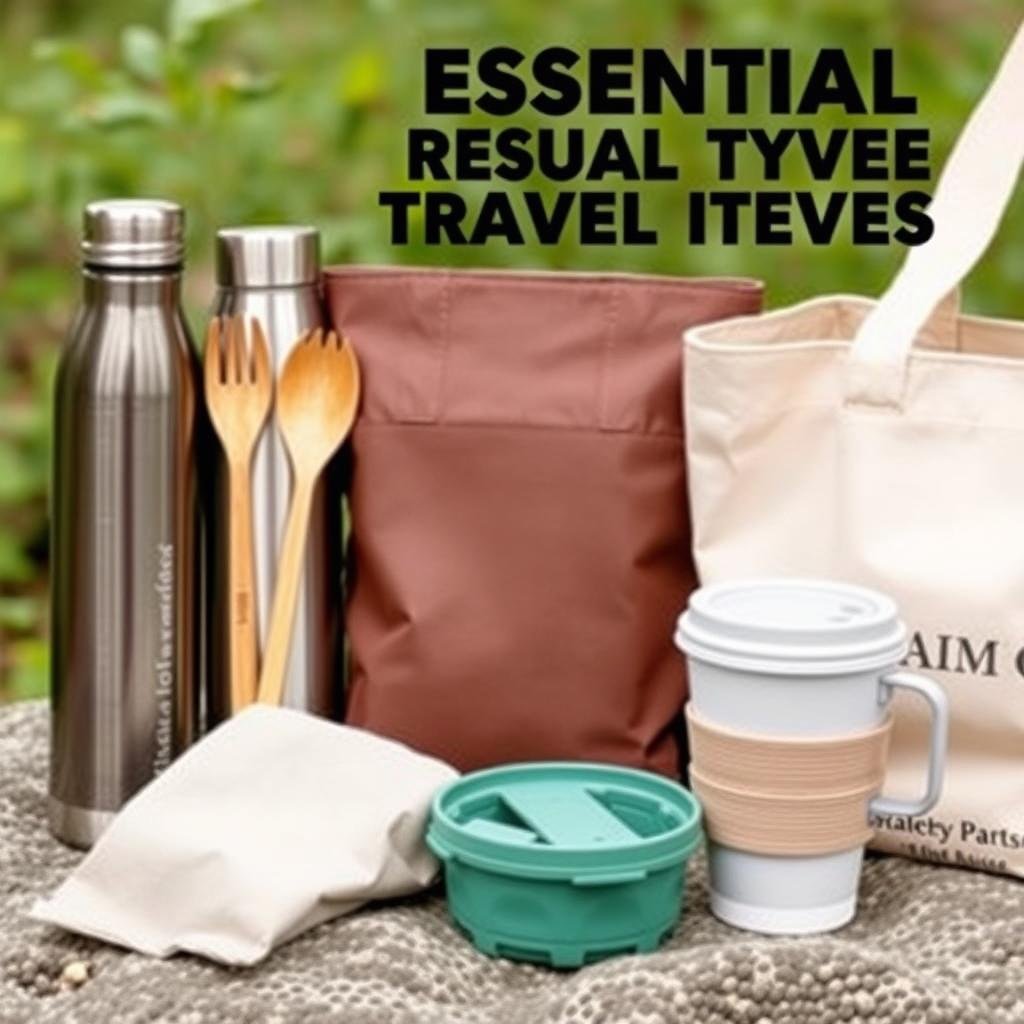
Essential reusable items for eco-friendly travel
Ready to eliminate single-use plastics on your travels?
Invest in quality reusable items that will last for years of adventures while helping protect the destinations you love.
3. Use Water Filtration Systems Instead of Bottled Water
Plastic water bottles are one of the most common waste items generated by travelers. In many destinations, tap water isn’t safe to drink, leading visitors to rely on bottled water. However, there are excellent alternatives that can save you money while reducing plastic waste.
Water Filtration Options
Modern water filtration systems are compact, effective, and perfect for travelers. They remove bacteria, parasites, and other contaminants, making tap water safe to drink almost anywhere in the world. The initial investment quickly pays for itself compared to buying bottled water throughout your trip.
| Filtration Type | Best For | Pros | Cons |
| UV Purifiers | Urban travel | Quick, effective against viruses | Requires batteries/charging |
| Filter Straws | Hiking, emergency use | Ultralight, no waiting | Limited volume |
| Bottle Filters | Daily use | Convenient, all-in-one | Bulkier than other options |
| Gravity Filters | Groups, base camps | Processes large volumes | Heavier, requires setup |
During my year traveling through Southeast Asia, my water filter saved approximately 1,500 plastic bottles while also saving me over $750 in bottled water costs.
4. Choose Eco-Friendly Accommodations
Where you stay has a significant environmental impact. Fortunately, there’s been tremendous growth in sustainable accommodation options ranging from eco-luxury resorts to green hostels. These properties implement water and energy conservation measures, waste reduction programs, and often support local community initiatives.
How to Identify Truly Sustainable Properties
Look for recognized eco-certifications that verify a property’s environmental claims. These certifications ensure the accommodation meets specific sustainability standards rather than just making vague “green” marketing claims. Some reputable certifications include Green Key, EarthCheck, LEED, and Rainforest Alliance.

Eco-certified accommodations implement comprehensive sustainability practices
Sustainable Accommodation Practices
Even if you can’t find a certified eco-hotel, look for properties that implement these key sustainability practices. Many smaller guesthouses and locally-owned accommodations have excellent environmental policies without formal certification. Ask about their specific sustainability initiatives before booking.
Find your perfect eco-friendly stay
Discover accommodations that align with your environmental values while providing unforgettable experiences.
5. Choose Sustainable Transportation Options
Transportation typically accounts for the largest portion of a trip’s carbon footprint. While flying is sometimes unavoidable, there are many ways to reduce your environmental impact when getting from place to place. Implementing these eco-friendly travel hacks for transportation can significantly lower your carbon emissions.
Prioritize Low-Carbon Transportation
When planning your itinerary, consider transportation options with lower environmental impacts. Trains are generally the most eco-friendly option for long-distance travel, producing up to 90% less carbon emissions than flying the same distance. Buses are another excellent option, especially for shorter routes.
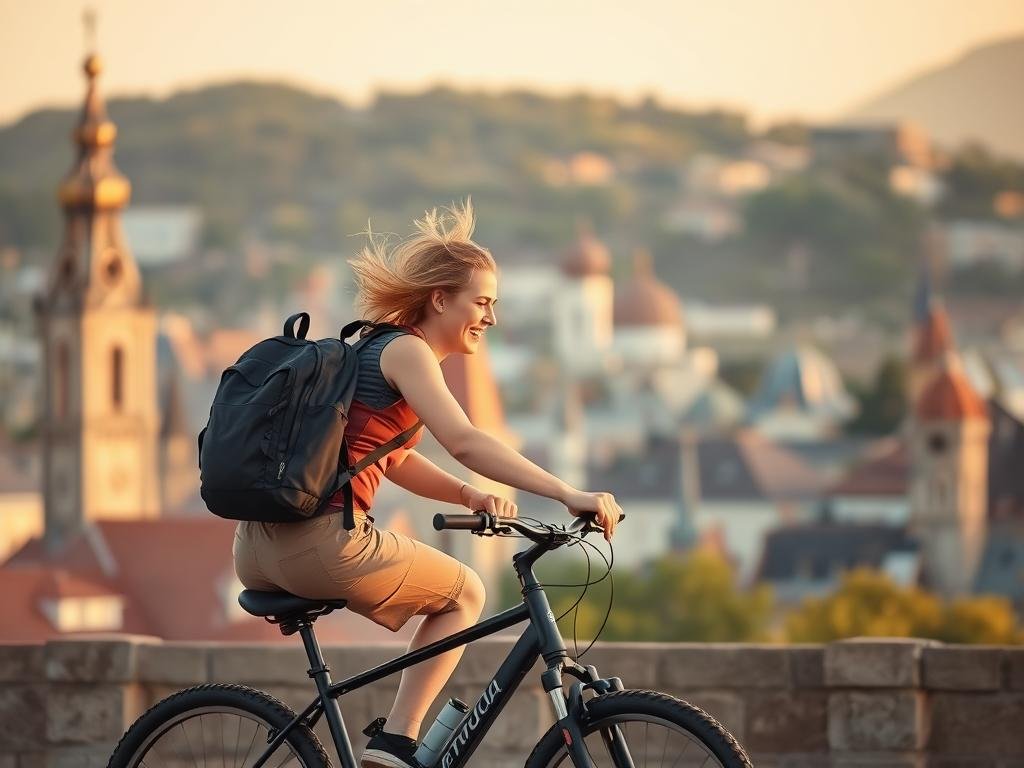
Cycling is one of the most sustainable and immersive ways to explore a destination
When You Must Fly
Sometimes air travel is unavoidable, especially for crossing oceans or reaching remote destinations. When you must fly, there are still ways to reduce your environmental impact. Choose direct flights whenever possible, as takeoffs and landings generate the most emissions. Consider airlines with newer, more fuel-efficient fleets and strong sustainability commitments.
Carbon Offsetting Tip: If you need to fly, consider purchasing carbon offsets to compensate for your flight’s emissions. Look for verified offset projects that fund renewable energy, forest conservation, or community-based initiatives.
6. Support Local Communities and Businesses
One of the most impactful eco-friendly travel hacks is directing your spending toward local businesses and communities. This approach reduces transportation emissions from imported goods while ensuring your tourism dollars benefit the destination you’re visiting. It also typically leads to more authentic and meaningful travel experiences.
Eat Local and Seasonal
Choose restaurants that source ingredients locally and seasonally. These establishments typically have smaller carbon footprints since their supplies don’t require long-distance transportation. Local food also tends to be fresher and provides authentic cultural experiences that connect you more deeply with your destination.
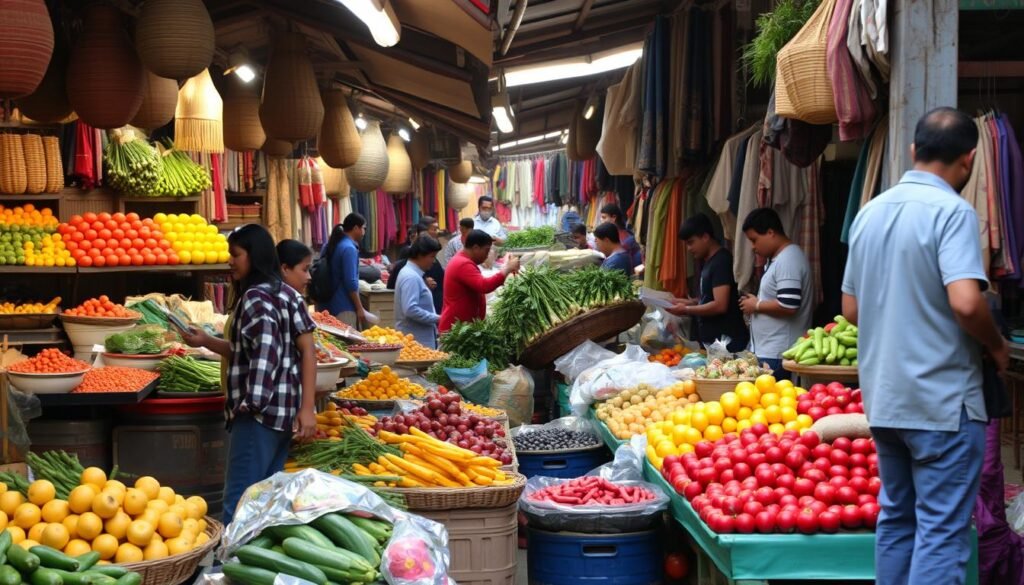
Local markets offer fresh, sustainable food options while supporting the local economy
Shop Responsibly
When purchasing souvenirs or necessities, seek out locally-made products from small businesses. Avoid mass-produced items that are likely imported. Look for artisanal crafts that showcase local traditions and skills, creating meaningful mementos of your journey while supporting local craftspeople.
7. Create a Plastic-Free Toiletry Kit
Conventional travel toiletries generate significant plastic waste through small bottles and packaging. Creating a plastic-free toiletry kit is an effective eco-friendly travel hack that reduces waste while often saving money in the long run. These sustainable alternatives work just as well as their plastic-packaged counterparts.
Essential Plastic-Free Toiletries
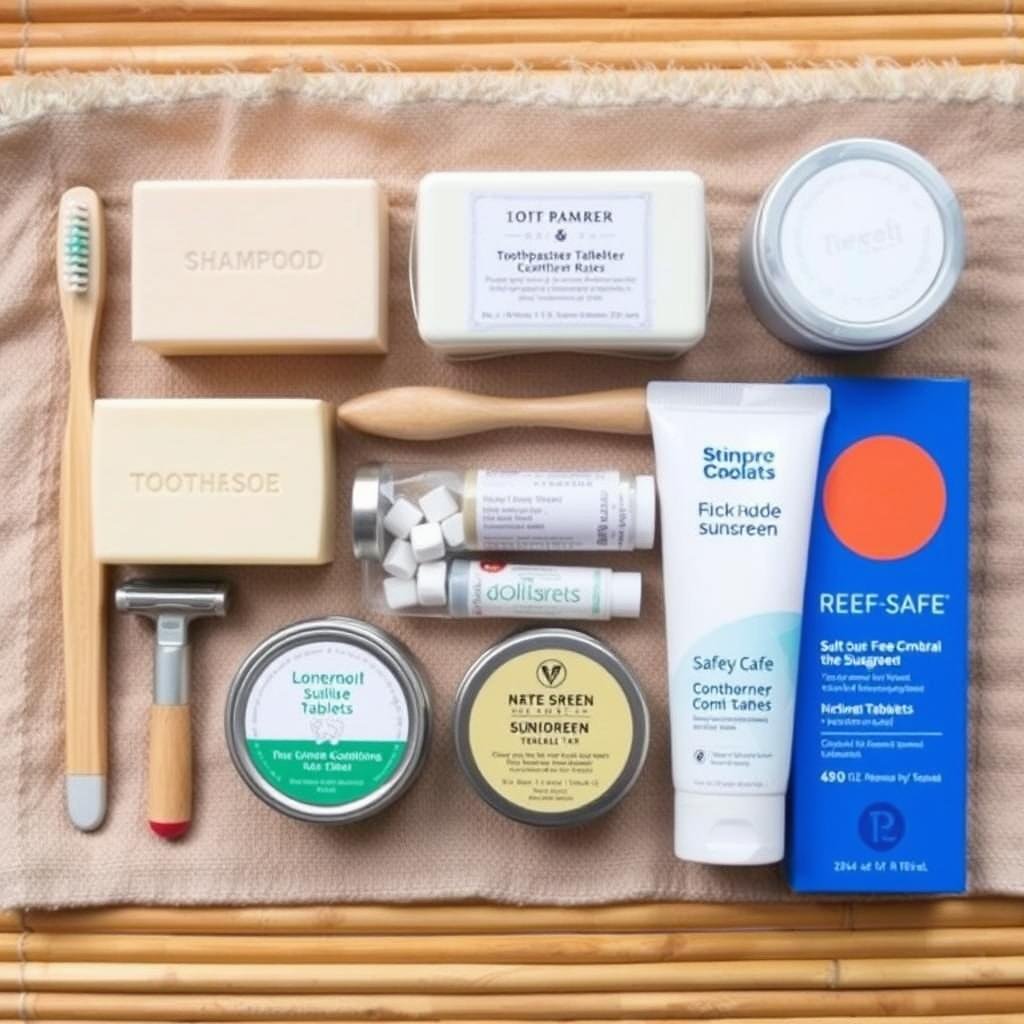
A complete plastic-free toiletry kit for eco-conscious travelers
Storage Solutions
Store your plastic-free toiletries in sustainable containers that keep them clean and dry. Beeswax wraps, small cotton bags, or metal tins work well for solid products. For any liquids you can’t replace with solids, look for refillable silicone bottles that you can use for years rather than disposable travel-sized containers.
Ready to go plastic-free on your next adventure?
Invest in sustainable toiletries that are better for the planet and will last for multiple trips.
8. Adopt Water and Energy Conservation Practices
Many destinations face water scarcity and energy challenges. By adopting simple conservation habits while traveling, you can significantly reduce your resource consumption. These eco-friendly travel hacks are easy to implement but make a meaningful difference, especially in regions with limited infrastructure.
Water Conservation Tips
Water is a precious resource in many destinations, particularly in arid regions or developing areas with limited infrastructure. By being mindful of your water usage, you can help preserve this essential resource for local communities and ecosystems. These simple habits make a significant difference when practiced consistently.
Energy-Saving Practices
Energy conservation reduces carbon emissions and helps destinations manage their resources more sustainably. Many regions still rely heavily on fossil fuels for electricity generation, making energy conservation an important part of responsible travel. These habits are similar to what you might practice at home but are even more important when traveling.

Eco-friendly accommodations often incorporate energy-saving design features
9. Practice Responsible Wildlife Tourism
Wildlife encounters can be among the most memorable travel experiences, but it’s crucial to ensure these interactions are ethical and sustainable. Many animal attractions harm wildlife despite marketing themselves as conservation-oriented. By making informed choices, you can enjoy authentic wildlife experiences that respect animal welfare and conservation principles.
Ethical Wildlife Viewing Guidelines
When observing wildlife, whether on a safari, snorkeling trip, or nature hike, follow these guidelines to minimize your impact. Responsible wildlife viewing prioritizes the animals’ natural behaviors and habitats while still providing meaningful encounters for travelers. These principles apply across all types of wildlife experiences.
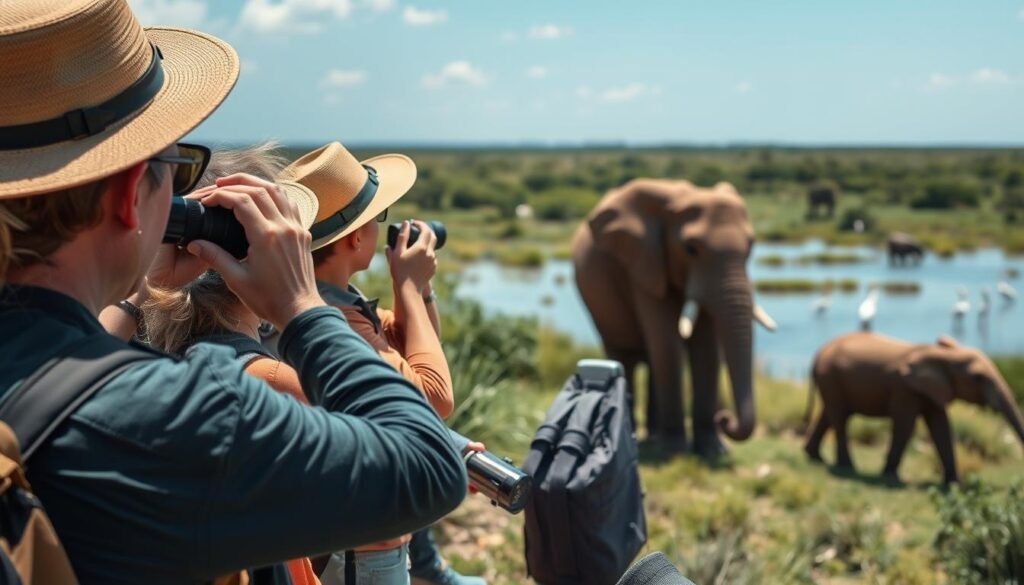
Responsible wildlife viewing maintains a respectful distance and prioritizes natural behaviors
Choosing Ethical Wildlife Experiences
Research wildlife attractions thoroughly before booking. Look for sanctuaries and conservation programs that prioritize animal welfare and natural behaviors rather than entertainment. True sanctuaries don’t breed animals for captivity or force them to perform unnatural behaviors for visitors. They typically focus on rehabilitation and conservation education.
Warning: Avoid attractions offering elephant rides, tiger cub petting, dolphin shows, or similar activities that exploit animals for entertainment. These practices typically involve cruel training methods and poor living conditions.
10. Practice Digital Minimalism While Traveling
The environmental impact of our digital habits is often overlooked. Data centers consume massive amounts of energy, and constant device charging adds to your carbon footprint. Implementing digital minimalism as an eco-friendly travel hack not only reduces your environmental impact but also helps you stay more present and engaged with your destination.
Reduce Digital Consumption
Limit unnecessary digital activities that consume energy and data. Download maps, guides, and entertainment before your trip rather than streaming continuously. Consider taking a partial digital detox during your travels, limiting social media use and unnecessary internet browsing to save energy and enhance your travel experience.

Solar chargers provide sustainable power for essential devices while traveling
Sustainable Tech Habits
When you do need to use technology, do so efficiently. Use power-saving modes on your devices and charge them during off-peak hours when possible. Consider investing in a solar charger for your devices, which allows you to harness renewable energy even in remote locations.
11. Offset Your Carbon Footprint
Even with the most diligent eco-friendly travel hacks, some environmental impact is inevitable. Carbon offsetting allows you to compensate for these emissions by investing in projects that reduce greenhouse gases elsewhere. While not a perfect solution, quality carbon offsets can help mitigate your travel impact while supporting valuable environmental and community projects.
How Carbon Offsetting Works
Carbon offsetting involves calculating your trip’s emissions and then purchasing “offsets” that fund projects reducing an equivalent amount of greenhouse gases. These projects might include renewable energy development, forest conservation, or methane capture from landfills. The goal is to balance out the emissions you couldn’t avoid generating.
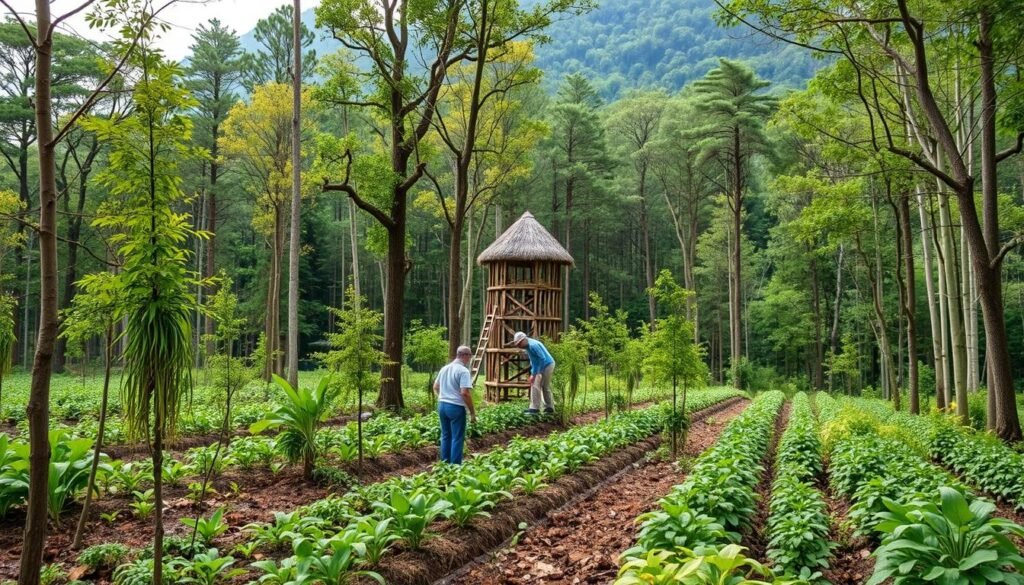
Reforestation projects are common carbon offset initiatives that help sequester CO2
Choosing Quality Offset Programs
Not all carbon offset programs are created equal. Look for certified projects verified by respected standards like Gold Standard, Verified Carbon Standard, or Climate Action Reserve. These certifications ensure the projects deliver real, measurable carbon reductions and often provide additional social benefits to local communities.
Ready to offset your travel emissions?
Calculate your carbon footprint and support verified projects that make a real difference.
12. Adopt Zero-Waste Food Practices
Food waste and packaging contribute significantly to travel’s environmental impact. By adopting zero-waste food practices, you can reduce both trash and carbon emissions associated with food production and transportation. These eco-friendly travel hacks for food also often lead to more authentic culinary experiences.
Zero-Waste Food Strategies
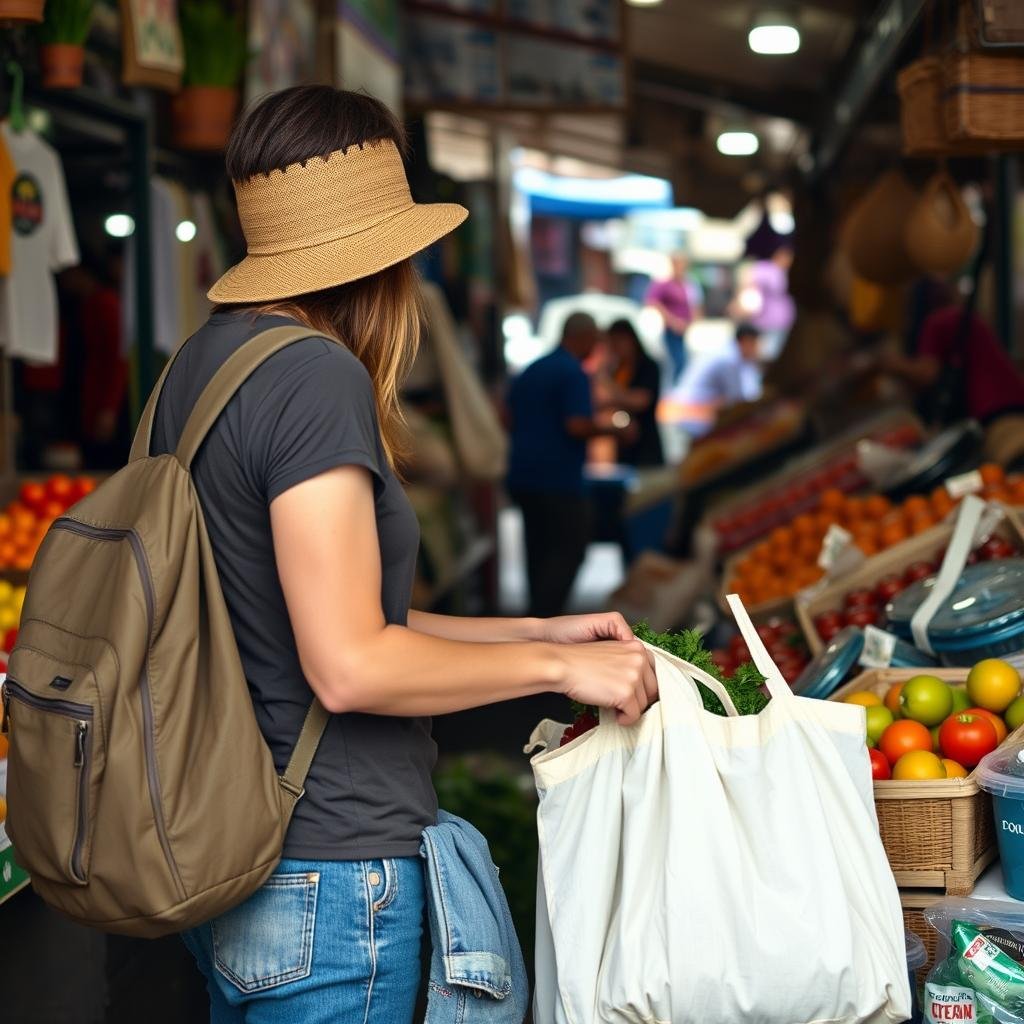
Shopping at local markets with reusable containers reduces packaging waste
Meal Planning for Sustainability
If you have access to cooking facilities, plan meals to minimize waste. Purchase only what you’ll use and get creative with leftovers. When eating out, consider sharing dishes to try more local specialties while avoiding food waste. Many destinations have traditional dishes designed to use all parts of ingredients, offering both sustainability and cultural insights.
13. Choose Sustainable Souvenirs
Souvenirs create lasting memories of your travels, but many conventional options have significant environmental impacts. By choosing sustainable alternatives, you can bring home meaningful mementos while supporting local artisans and reducing environmental harm. These eco-friendly travel hacks for souvenir shopping enhance both your travel experience and your impact.
Sustainable Souvenir Ideas
Look for items that are locally made from sustainable materials and support traditional crafts. These souvenirs typically have lower carbon footprints than mass-produced items while providing more authentic connections to the places you visit. They also help preserve cultural heritage and traditional skills that might otherwise be lost.

Locally-made crafts support traditional skills and sustainable materials
What to Avoid
Steer clear of souvenirs made from endangered species, coral, shells, or ancient artifacts. These items may be illegal and contribute to environmental degradation or cultural heritage loss. Also avoid mass-produced “local” souvenirs that are actually manufactured elsewhere and shipped to tourist destinations.
14. Use Eco-Friendly Travel Apps
Technology can be a powerful ally in sustainable travel. A growing number of apps help travelers make more environmentally friendly choices, from finding green accommodations to locating plastic-free dining options. These digital tools make implementing eco-friendly travel hacks easier and more accessible.
Essential Sustainable Travel Apps
These apps cover different aspects of eco-friendly travel, from transportation to accommodation to daily activities. Having a few key sustainability apps on your phone can help you make better choices throughout your journey. Many also connect you with like-minded travelers and local sustainability initiatives.
| App Name | Purpose | Key Features |
| Green Maps | Find eco-friendly businesses | Maps of sustainable shops, restaurants, and accommodations |
| Refill | Reduce plastic waste | Locates water refill stations and plastic-free shops |
| Too Good To Go | Reduce food waste | Connects users with restaurants selling surplus food at discount |
| Ecosia | Eco-friendly search engine | Plants trees with search ad revenue |
| HappyCow | Find plant-based dining | Global directory of vegan and vegetarian restaurants |
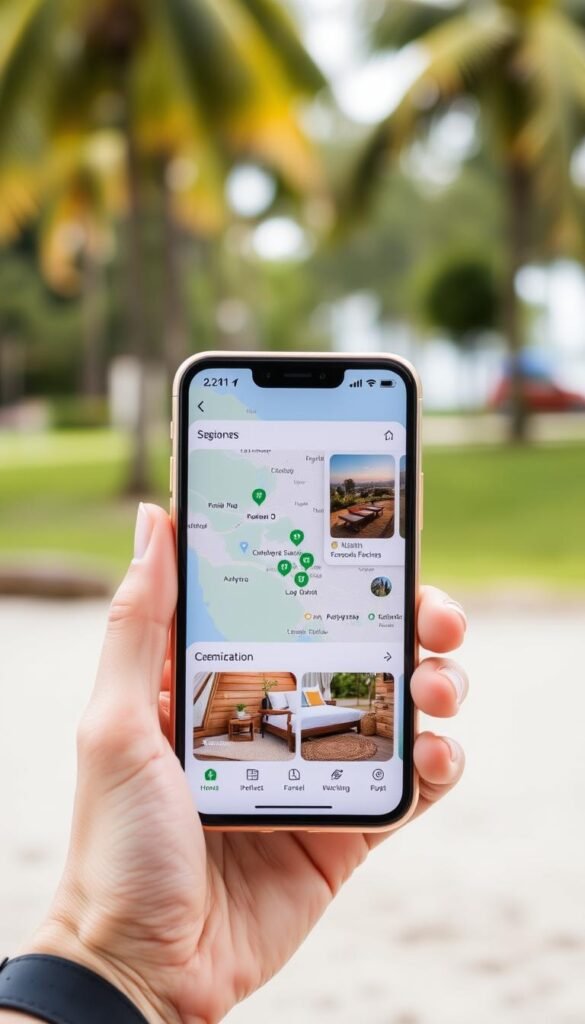
Eco-friendly apps help travelers make sustainable choices on the go
15. Share Your Knowledge and Inspire Others
One of the most powerful eco-friendly travel hacks is sharing your sustainable practices with others. By documenting your experiences and lessons learned, you can inspire fellow travelers to adopt more environmentally friendly habits. This multiplier effect extends your positive impact far beyond your own journey.
Ways to Share Your Sustainable Travel Journey
There are many platforms and methods for sharing your sustainable travel experiences. Choose approaches that feel authentic to you and reach audiences who might be receptive to adopting new practices. Focus on the positive aspects of sustainable travel rather than shaming others for their choices.
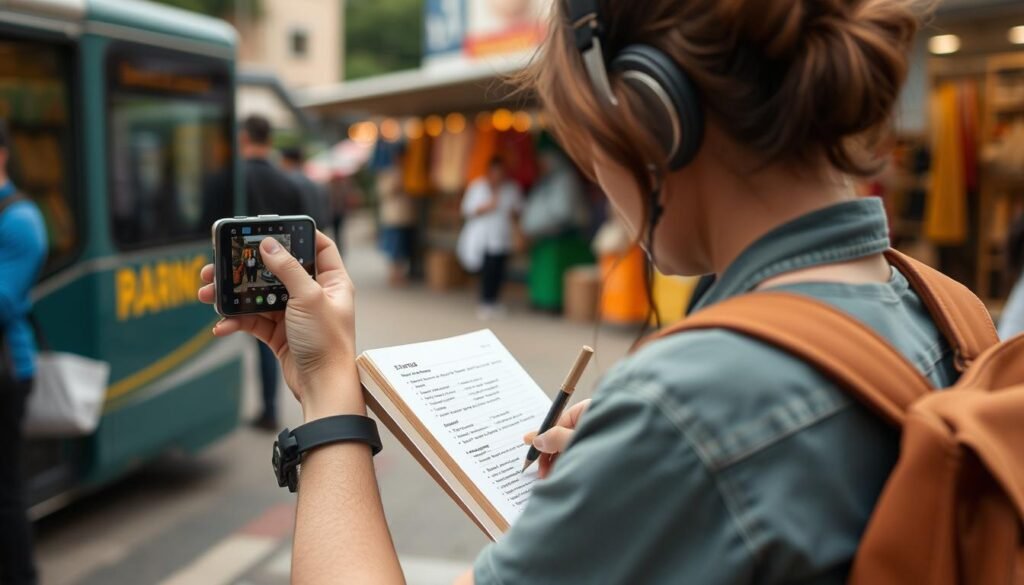
Sharing your sustainable travel experiences can inspire others to adopt similar practices
Engage with Local Sustainability Initiatives
Connect with local environmental organizations or community projects during your travels. Many welcome volunteer support or donations from visitors. These experiences provide deeper insights into local sustainability challenges while creating meaningful connections with residents working to protect their environment and culture.
Frequently Asked Questions About Eco-Friendly Travel
Is sustainable travel more expensive than conventional travel?
Not necessarily. While some eco-friendly accommodations or products may have higher upfront costs, many sustainable travel practices actually save money. Packing light avoids baggage fees, reusable items eliminate ongoing purchases, and local transportation is typically cheaper than taxis or car rentals. Eating locally and reducing consumption generally lowers expenses.
The key is balancing occasional investments in quality, sustainable gear with the many cost-saving aspects of eco-friendly travel. Over time, sustainable travel often proves more economical than conventional approaches.
How can I verify if an accommodation is truly eco-friendly?
Look for recognized eco-certifications like Green Key, EarthCheck, LEED, or Rainforest Alliance. These programs require properties to meet specific environmental standards and undergo regular audits. You can also research the property’s specific sustainability initiatives on their website or by contacting them directly with questions.
Be wary of vague claims like “eco-friendly” or “green” without specific details about practices. True eco-accommodations will be transparent about their sustainability measures and often showcase them prominently.
What’s the most effective way to reduce my carbon footprint while traveling?
The single most effective way is to reduce air travel, as flights typically account for the largest portion of travel emissions. Consider destinations accessible by train or bus, or stay longer in fewer locations rather than taking multiple short trips requiring flights.
When flying is necessary, choose direct flights on fuel-efficient airlines, pack light, and consider offsetting your emissions through reputable carbon offset programs. Once at your destination, use public transportation, walk, or cycle rather than renting a car or taking taxis.
How can I avoid single-use plastics in countries where tap water isn’t safe?
Invest in a quality water purification system like a UV purifier, filter bottle, or filter straw. These allow you to safely drink local water without relying on bottled water. Some destinations also have water refill stations specifically for travelers.
If you must buy bottled water, purchase the largest size available to reduce packaging waste per liter, then refill your day bottle from it. In some countries, you can also find water in glass bottles, which have a lower environmental impact than plastic.
Embrace Sustainable Travel for a Better World
Implementing these eco-friendly travel hacks allows you to explore the world while preserving its beauty for future generations. Sustainable travel isn’t about perfection—it’s about making conscious choices that collectively create significant positive impact. Even adopting just a few of these practices can substantially reduce your environmental footprint.
Remember that sustainable travel often enhances your experience by connecting you more deeply with destinations and local communities. By traveling mindfully, you’ll likely discover more authentic experiences and meaningful connections than conventional tourism typically offers.
We’d love to hear about your own eco-friendly travel hacks and experiences. Share your sustainable travel stories and tips in the comments below to inspire fellow travelers on their journey toward more responsible exploration.
Ready to transform your travel experience?
Start implementing these eco-friendly travel hacks on your next adventure and become part of the sustainable tourism movement.
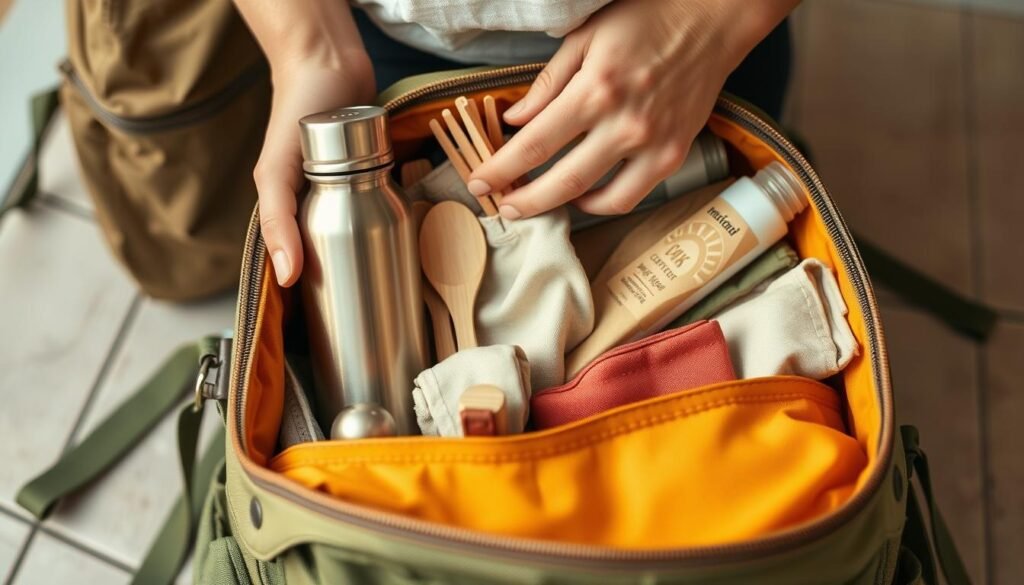
Packing sustainably with reusable essentials reduces your environmental impact while traveling
| Section | Key Benefits | Difficulty Level |
| Sustainable Packing | Reduces waste, lightens load | Easy |
| Eco-Friendly Accommodations | Supports green businesses, reduces energy use | Medium |
| Sustainable Transportation | Lowers carbon emissions | Medium |
| Local Community Support | Boosts local economy, authentic experiences | Easy |
| Carbon Offsetting | Compensates for unavoidable emissions | Easy |

